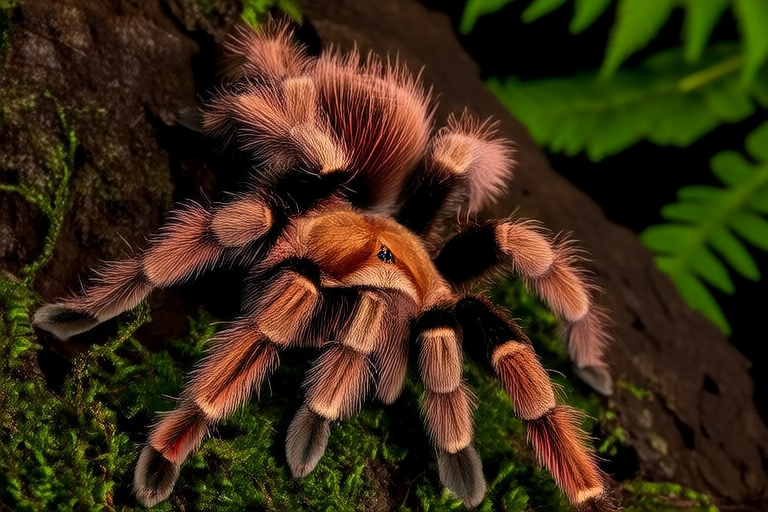From Jungle to Home: Transforming Your Space with a Chilen Rose Tarantula
Welcome to the fascinating world of exotic pets! Among the most popular and captivating choices is the Grammostola rosea, commonly known as the Chilean Rose tarantula. This spider, native to the deserts and scrublands of Chile, Bolivia, and Argentina, is not only a striking addition to any collection but also an ideal pet for beginners due to its docile nature and relatively low maintenance. In this article, we will explore the unique characteristics of the Chilean Rose tarantula, delve into its care requirements, guide you through setting up a suitable habitat at home, debunk common myths about living with tarantulas, and provide valuable tips for初次注入.
The Unique Characteristics of the Chilean Rose Tarantula
The Chilean Rose tarantula is renowned for its distinct appearance and behavior. Its body is covered in short, velvety hairs that range from light pink to deep rose, giving it its namesake coloration. These hairs are not only aesthetically pleasing but also serve a functional purpose, acting as a defense mechanism against predators. When threatened, the tarantula can release these hairs, which irritate the predator’s eyes and nose.
Unlike many other spiders, the Chilean Rose tarantula is relatively slow-moving and docile. It prefers to hide rather than hunt, making it less likely to bite humans unless provoked. This makes it an excellent choice for those who are new to keeping arachnids as pets. Additionally, they have a lifespan of approximately 8 to 12 years, offering a long-term companionship.
Care Requirements for Your Chilean Rose Tarantula
Maintaining a healthy and happy Chilean Rose tarantula requires attention to specific care requirements. Proper nutrition is crucial, as their diet primarily consists of insects such as crickets, mealworms, and wax moths. Juvenile tarantulas should be fed smaller prey items more frequently, while adults can be fed once every week or two.
Temperature and humidity are equally important factors in maintaining a suitable environment for your tarantula. The ideal temperature range for the Chilean Rose tarantula is between 75°F and 85°F (24°C to 29°C). Humidity levels should be kept around 60% to 70%, mimicking the arid conditions of their natural habitat. You can achieve this by misting the enclosure occasionally and providing a shallow water dish.
Suitable Habitat Setup at Home
Creating the right habitat is essential for the well-being of your Chilean Rose tarantula. A glass or plastic terrarium with a secure lid is recommended, ensuring that your pet cannot escape. The terrarium should be spacious enough to allow for climbing and hiding, with a minimum size of 10 gallons for an adult tarantula.
Inside the terrarium, include a variety of substrates such as coconut fiber, cypress mulch, or reptile bark to mimic the natural ground cover found in the wild. Add branches, cork bark, and artificial plants to create hiding spots and climbing structures. Ensure that the enclosure has adequate ventilation to prevent moisture buildup, which can lead to respiratory issues.
Myths vs Realities About Living With Tarantulas
One of the most common misconceptions about tarantulas is that they are aggressive and dangerous. While all spiders possess venom, the Chilean Rose tarantula’s venom is mild and comparable to a bee sting. They are generally non-aggressive and will only bite if they feel threatened or cornered. Another myth is that tarantulas are solitary creatures that require no social interaction. While they do prefer solitude, occasional handling can help build trust and reduce stress.
It’s also important to dispel the notion that tarantulas are difficult to care for. With proper research and preparation, owning a Chilean Rose tarantula can be a rewarding experience. Regular cleaning of the enclosure and monitoring for signs of illness or injury are key to ensuring your pet’s health.
Tips for初次注入
When introducing a new Chilean Rose tarantula to its habitat, it’s important to acclimate it slowly to its new environment. Start by placing the enclosure in a quiet area away from direct sunlight or drafts. Allow your tarantula to explore its new home at its own pace, providing plenty of hiding spots to make it feel secure.
Regular handling can help familiarize your tarantula with human contact, but always approach with caution. Use gentle, slow movements and avoid sudden jerks or loud noises. If you need to move your tarantula, gently scoop it up with a soft brush or paper towel, supporting its body and legs carefully.
Lastly, observe your tarantula regularly for any changes in behavior or physical condition. Signs of distress may include lethargy, refusal to eat, or unusual webbing patterns. If you notice any concerning symptoms, consult a veterinarian specializing in exotic animals for advice.
Conclusion
Owning a Chilean Rose tarantula can be a unique and enriching experience. By understanding their unique characteristics, meeting their care requirements, and creating a suitable habitat, you can provide a safe and comfortable home for your new pet. Remember to dispel common myths and approach your tarantula with patience and respect. With proper care and attention, your Chilean Rose tarantula will thrive in its new jungle-to-home environment.
